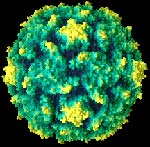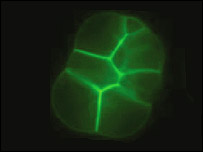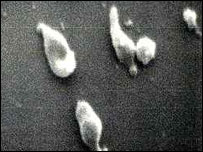
january 2005
Scientists have assembled the first synthetic
virus. By Dr David Whitehouse
BBC News Online science editor July 11,2002.
The US researchers built the infectious agent from scratch using the genome sequence for polio.
It was just a matter of time before it was done : Dr CJ Peters, University of Texas, WELL HE WOULD SAY THAT WOULDN'T HE !!
Scientists are divided about whether a virus is alive. For those that think it is, then this synthetic artefact would constitute a simple form of life.
Responding to criticisms that such
research could lead to bioterrorists engineering new
lethal viruses, the scientists behind the experiment said
that only a few people had the knowledge to  make it happen.
make it happen.
'New reality'
To construct the virus, the researchers say they followed a recipe they downloaded from the internet and used gene sequences from a mail-order supplier.
Having constructed the virus, which appears to be identical to its natural counterpart, the researchers, from the University of New York at Stony Brook, injected it into mice to demonstrate that it was active.
The animals were paralysed and then died.
"The reason we did it was to prove that it can be done and it now is a reality," said Dr Eckard Wimmer, leader of the biomedical research team and co-author of the study published in the journal Science.
"This approach has been talked about, but people didn't take it seriously," said Dr Wimmer.
"Now people have to take it seriously. Progress in biomedical research has its benefits and it has its down side. There is a danger inherent to progress in sciences. This is a new reality, a new consideration."
UPDATE:
Artificial
life' comes step closer
By Roland Pease, 18th Dec.2004
BBC radio science unit
Researchers at Rockefeller University in the US have made the first tentative steps towards creating a form of artificial life.
Their creations, small synthetic vesicles that can process (express) genes, resemble a crude kind of biological cell.
 The parts for their "vesicle
bioreactors", as they call them, all come from
diverse realms of life.
The parts for their "vesicle
bioreactors", as they call them, all come from
diverse realms of life.
The soft cell walls are made of fat molecules taken from egg white. The cell contents are an extract of the common gut bug E. coli, stripped of all its genetic material.
This essence of life contains ready-made much of the biological machinery needed to make proteins; the researchers also added an enzyme from a virus to allow the vesicle to translate DNA code.
When they added genes, the cell fluid started to make proteins, just like a normal cell would.
Jelly fish
A gene for green fluorescent protein taken from a species of jellyfish was the first they tried. The glow from the protein showed that the genes were being transcribed.
With a second gene, from the bacterium Staphylococcus
aureus, the researchers got their cells to make small
 pores in their walls.
pores in their walls.
Some bacteria can survive with just a few hundred genes such as this Mgenitalium bacteria......................................................................................
These let nutrients in from the surrounding "soup", so that the cells could function, in some instances, for several days.
Albert Libchaber, who heads the project, stresses that these bioreactors are not alive - they're performing simple chemical reactions that can also happen in cell-free biological fluids.
But the research is one strand in a new field called synthetic biology, where the aim is to re-design entire organisms, or recreate them from scratch.
The bio-entrepreneur Craig Venter, who headed the commercial venture to decode the human genome, is currently trying to strip a bacterium down to the minimum set of genes needed for survival.
Synthetic virus
Two years ago, another team showed that polio viruses could assemble themselves from off-the-shelf chemical components mixed in a test-tube.
And several chemists are exploring the kinds of chemical reactions that may have preceded life.
Albert Libchaber's hope is to build up towards a minimal synthetic organism, with a designed cell wall, and a mixture of gene circuits that would let it maintain itself like a living cell.
As these constructs become more lifelike, the rest of us will have to start rethinking the nature of life.
"This is rather philosophical," says Dr Libchaber.
"For me, life is just like a machine - a machine with a computer program. There's no more to it than that. But not everyone shares this point of view," he told the BBC.
He also stresses that there is no danger in the experiments. Not only are his cells artificial, they can function only in the nutrient medium he supplies them.
He said: "If you take our system out of its environment, it just doesn't function."
Details of Libchaber's work with Vincent Noireaux have been published by the journal Proceedings of the National Academy of Sciences.